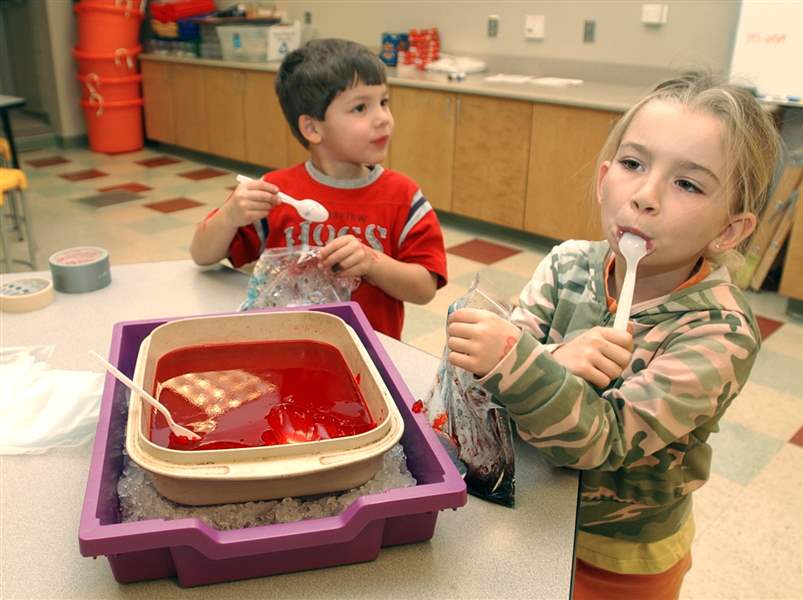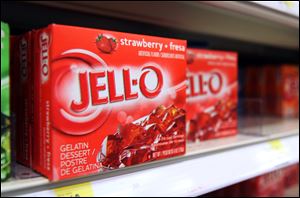
TREAT WOBBLES IN POPULARITY
Jell-O can’t stop slippery sales slide
Jell-O's revitalization efforts turn out to be a big flop
9/2/2014
Jell-O has seen its sales fall by nearly one-fifth in four years as other snacks have surged. Kraft is trying to fight the fall by promoting creative recipes on social media sites such as Pinterest.
(LAWRENCE, KAN.) JOURNAL-WORLD

The vivid colors of Jell-O inadvertently raise concerns about artificial dyes as ingredients.
NEW YORK — Jell-O has lost its jiggle, and nobody knows how to fix it.
The dessert was invented more than a century ago and helped popularize a delicacy reserved for the rich into a quick, affordable treat. Americans of all ages are familiar with the famous “J-E-L-L-O” jingle and TV ads featuring comedian Bill Cosby. Knocking back Jell-O shots made with alcohol is a college memory for many.
Yet despite its enduring place in pop culture, sales have tumbled 19 percent in the last four years, with alternatives such as Greek yogurt surging. Executives at Kraft Foods Group Inc., which owns Jell-O, say they’re confident they can revitalize the brand. But their efforts so far have disappointed.
After years of marketing sugar-free Jell-O to dieters, for instance, Kraft last year launched an ad campaign that switched back to playing up the family angle. In one TV spot called “Comb Over,” a man with the title hairdo tells his son how Jell-O makes up for life’s troubles, such as being stuck in traffic. The gag is when the child imagines himself with a comb over.
“Kids thought it was hilarious,” said Dan O’Leary, senior director of marketing for Kraft desserts.
But it didn’t get people in the mood to eat Jell-O. After showing signs of improvement for a couple years, Jell-O sales in the United States hit $932.5 million in 2009, reflecting box mixes and ready-to-eat cups of gelatins and puddings, according to market researcher Euromonitor International. But they’ve been falling ever since, and by last year, sales had dropped by a double-digit percent to $753.8 million.
Part of the problem is that people are increasingly seeking out foods they think are natural or wholesome, and Jell-O’s bright reds, greens, and blues may serve as warnings about artificial dyes. The second ingredient listed for the Jell-O gelatin cups is high-fructose corn syrup, a cheaper sugar substitute that more people are shunning.
Nutrition more broadly is another issue. Jell-O has positioned itself as a lighter alternative to cakes and pies (as the slogan goes, “There’s always room for Jell-O”). But the trend now is toward foods that claim some sort of benefit, such as protein and fiber.
Even for those who have fond memories of eating Jell-O, the problem is just that — it’s a treat associated with the past.
“It almost seems childish to cook it now,” said Ted McGrath, a 34-year-old painter in New York City who thinks of Jell-O as being in the same category as Twinkies or fast food.
Chief Executive Officer Tony Vernon of Kraft concedes Jell-O wasn’t “getting the attention it deserved” as a storied brand. That’s because the company for many years was preoccupied by more popular snacks, such as Oreo and Chips Ahoy cookies. But in late 2012, Kraft split into two companies and the new Mondelez International walked away with those higher-profile snacks.
Since the separation, Kraft has vowed to boost the performance of neglected brands such as Jell-O. None of the efforts so far have worked, but executives remain optimistic.
People in their 20s and 30s, for instance, love expressing their creativity through cooking, yet want the convenience of packaged foods, Mr. O’Leary notes.
So Kraft says it’s encouraging people to get creative with Jell-O on social media sites such as Pinterest, Facebook, and Instagram. By posting images of Jell-O creations, the company says others get inspired to share their own, such as an image of a red, white, and blue Jell-O ring one follower posted on Facebook posted on July 4. It’s also pushing new Jell-O molds, such as a line of university molds that allow people to make Jell-O in the shape of their school mascots.
Jell-O can cling to one advantage: the nostalgia it evokes.
That’s on display at the Jell-O Gallery in Le Roy, N.Y., where Jell-O was invented. The museum — essentially a room in the LeRoy Historical Society — still gets between 10,000 to 13,000 visitors a year, says Lynne Belluscio, director.
The Jell-O Gallery remains the star attraction. And once people step inside, the memories come tumbling forth.
“It’s really funny how many people come here and say, ‘Oh man, I haven’t had Jell-O in so long,’ ” Ms. Belluscio said.